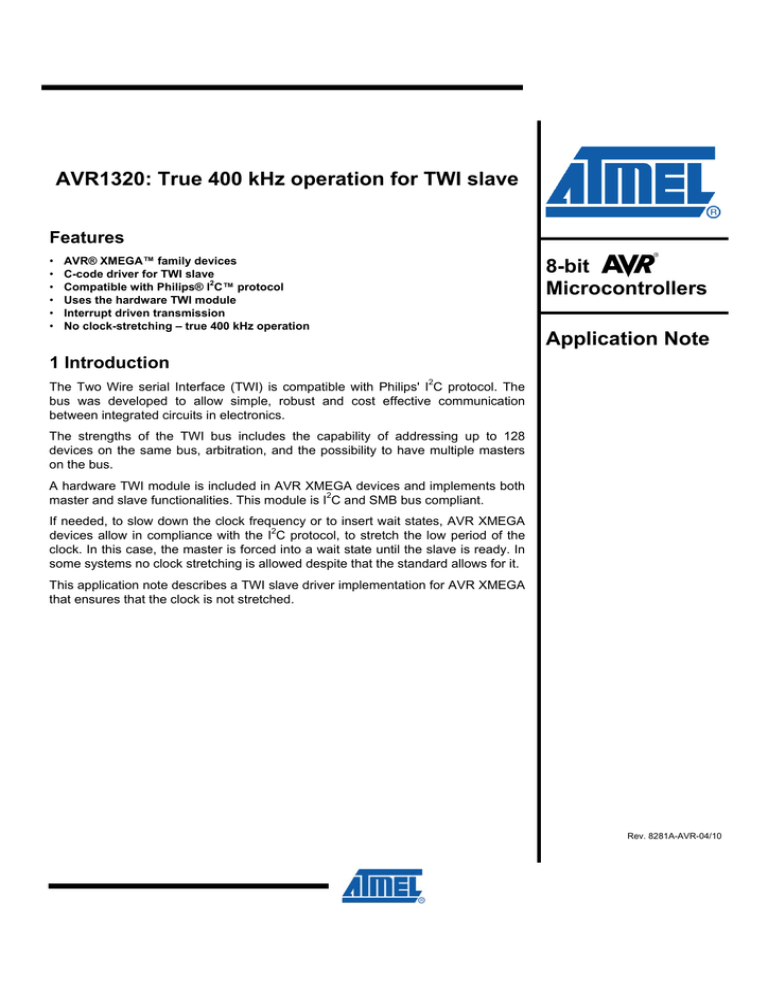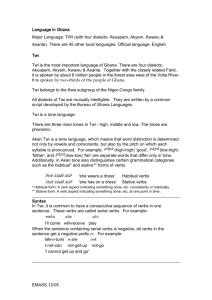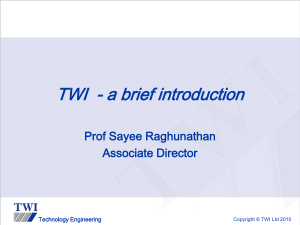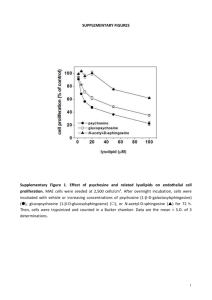
AVR1320: True 400 kHz operation for TWI slave
Features
•
•
•
•
•
•
AVR® XMEGA™ family devices
C-code driver for TWI slave
2
Compatible with Philips® I C™ protocol
Uses the hardware TWI module
Interrupt driven transmission
No clock-stretching – true 400 kHz operation
8-bit
Microcontrollers
Application Note
1 Introduction
The Two Wire serial Interface (TWI) is compatible with Philips' I2C protocol. The
bus was developed to allow simple, robust and cost effective communication
between integrated circuits in electronics.
The strengths of the TWI bus includes the capability of addressing up to 128
devices on the same bus, arbitration, and the possibility to have multiple masters
on the bus.
A hardware TWI module is included in AVR XMEGA devices and implements both
master and slave functionalities. This module is I2C and SMB bus compliant.
If needed, to slow down the clock frequency or to insert wait states, AVR XMEGA
devices allow in compliance with the I2C protocol, to stretch the low period of the
clock. In this case, the master is forced into a wait state until the slave is ready. In
some systems no clock stretching is allowed despite that the standard allows for it.
This application note describes a TWI slave driver implementation for AVR XMEGA
that ensures that the clock is not stretched.
Rev. 8281A-AVR-04/10
2 TWI theory
This section gives a short description of the TWI interface in general and the TWI
module on AVR XMEGA. For more detailed information refer to the datasheet.
2.1 Two wire serial interface
The TWI is ideally suited for typical microcontroller applications. The TWI protocol
allows the system designer to interconnect up to 128 individually addressable devices
using only two bi-directional bus lines, one for clock (SCL) and one for data (SDA).
The only external hardware needed to implement the bus is a single pull-up resistor
for each of the TWI bus lines. All devices connected to the bus have individual
addresses, and mechanisms for resolving bus contention are inherent in the TWI
protocol.
Figure 2-1. TWI Bus Topology
V CC
RP
RP
TWI
DEVICE #1
TWI
DEVICE #2
TWI
DEVICE #N
RS
RS
RS
RS
RS
RS
SDA
SCL
Note: RS is optional
The TWI bus is a multi-master bus where one or more devices, capable of taking
control of the bus, can be connected. Only Master devices can drive both the SCL
and SDA lines while a Slave device is only allowed to issue data on the SDA line.
Data transfer is always initiated by a Master device. A high to low transition on the
SDA line while SCL is high is defined to be a START condition or a repeated START
condition.
A START condition is always followed by the (unique) 7-bit slave address and then by
a Data Direction bit. The addressed Slave device sends an acknowledge to the
Master by holding SDA low for one clock cycle. If the Master does not receive any
acknowledge the transfer is terminated.
Depending on the Data Direction bit, the Master or Slave transmits 8-bit of data on
the SDA line. The receiving device then acknowledges the data. Multiple bytes can be
transferred in one direction before a repeated START or a STOP condition is issued
by the Master.
The transfer is terminated when the Master issues a STOP condition. A STOP
condition is defined by a low to high transition on the SDA line while the SCL is high.
All data packets transmitted on the TWI bus are 9 bits long, consisting of one data
byte and an acknowledge bit.
2
AVR1320
8281A-AVR-04/10
AVR1320
During a data transfer, the master generates the clock, START and STOP conditions,
while the receiver is responsible for acknowledging the reception. An acknowledge
(ACK) is signaled by the receiver pulling the SDA line low during the ninth SCL cycle.
If the receiver leaves the SDA line high, a NACK is sent.
2.2 TWI Clock stretching
According to the I2C standard, all devices connected to the bus are allowed to stretch
the low period of the clock to slow down the overall clock frequency or to insert wait
states while processing data. A device that needs to stretch the clock can do this by
holding/forcing the SCL line low after it detects a low level on the line (possible since
the lines are driven low by open-drain and have pull-up resistors).
If the device is in a sleep mode and a START condition is detected the clock is
stretched during the device wake-up period. To avoid clock stretching in relation to
use of sleep, only sleep mode with sufficiently fast wake-up time should be used. This
could be e.g. IDLE, Standby and Extended Standby mode.
3 AVR XMEGA Slave mode - stretchless operation
If the customer application doesn’t support clock stretching, the AVR1320 proposes a
true 400 kHz TWI operation for an AVR XMEGA TWI slave.
The TWI hardware module is common to AVR XMEGA. The AVR1320 software tests
are performed on ATxmega128A1, but the driver is compatible with any AVR
XMEGA.
3.1 TWI slave operation
The TWI slave is byte-oriented with optional interrupts after each byte. There are
separate slave Data Interrupt and Address/Stop Interrupt. Interrupt flags can also be
used for polled operation. There are dedicated status flags for indicating ACK/NACK
received, clock hold, collision, bus error and read/write direction.
When an interrupt flag is set, the SCL line is forced low. This will give the slave time
to respond or handle any data, and will in most cases require software interaction.
The interrupt service routine (ISR) process needs to manage three major states:
• Slave address interrupt (see section 3.2)
• Data byte interrupt in write mode (see section 3.4)
• Data byte interrupt in read mode (see section 3.3).
3
8281A-AVR-04/10
Figure 3-1. Slave operation.
Initialize slave
Start
condition?
No
Yes
Address
+ R/W bit
Address
recognized?
No
Yes
Need to
signal error?
Yes
Write ctrl. reg. B
Slave NACK
No
Write ctrl. reg. B
Slave ACK
Operation
Transmit
Receive
Repeated
start
Receive
Stop
Data
Read data register
Write ctrl. reg. B
No
Need to
signal error?
Write data register
Transmit data
Master (N)ACK
Slave ACK
Yes
Write ctrl. reg. B
Slave NACK
Legend
Master ACK?
Yes
Hardware / bus
action
No
Repeated start
4
Receive
Stop
Software action
AVR1320
8281A-AVR-04/10
AVR1320
3.2 Reception of first byte (address)
In slave mode, the AVR XMEGA AVR receives a first byte with address and R/W bit
(Data Direction). Then, the 9th bit is dedicated to the ACK or NACK bit.
An interrupt occurs after the 8th bit. During the execution of the ISR, the AVR XMEGA
holds SCL line low. SCL is released when Address/Stop Interrupt Flag (APIF) is
cleared in STATUS register by clearing APIF or writing to CMD bits.
If the TWI master does not support the clock stretching, the SCL line frequency during
the 8 first bits and the 9th must be same, and the SCL line must thus be released by
the slave in due time to not stall the TWI master. In this case, the interrupt timing
determines the maximum frequency allowed by the TWI interface.
3.3 Write operation – slave received data
If the R/W bit of the address byte is equal to 0, a write operation is performed by the
master. After the 8th bit of the address byte, an interrupt occurs and the program
jumps to the ISR. The first data byte from the master will be available in TWI DATA
register when the next interrupt occurs. After a TWI write command, the data from the
master must be recovered before the next byte is received.
3.4 Read operation – slave transmits data
If the R/W bit of the address byte is equal to 1, a read operation is performed by the
master. After the 8th bit of the address byte, an interrupt occurs and the program
jumps to the ISR. The first data byte to read needs to be loaded in the TWI DATA
register during the ISR, without stretching the clock.
3.5 SCL description
The TWI frequency limit depends on time to release SCL in the ISR function. When
APIF or Data Interrupt Flag (DIF) are set (see STATUS register), the slave forces the
SCL line low. Clearing the interrupt flags will release the SCL line.
DIF or APIF are automatically cleared when:
•
•
•
•
Writing a 1 in the corresponding bit location
Writing to the slave DATA register
Reading the slave DATA register
Writing a valid command to the CMD bits in the CTRLB register
5
8281A-AVR-04/10
4 Hardware description
4.1 CPU clock
If the CPU clock of the TWI slave is increased more CPU cycles are available before
the SCL must be release, and it is thus an advantage to run the TWI slave from a fast
clock source to avoid clock stretching. AVR XMEGA offers a 32 MHz internal
oscillator. The system clock control register is used to select the clock source.
4.2 Pull up values on SDA and SCL pins
SCL and SDA pads are open drain and need pull up resistors.
2kOhms resistor values are recommended to have correct edges for a 400 kHz
frequency on TWI bus.
5 Software description
5.1 List of files
The source code package consists in the following files (and corresponding header
files):
•
•
•
•
twi_example.c
twi_slave_driver.c
twic_it.asm
clksys_driver.c
For a complete overview of the available driver interface functions and their use,
please refer to the source code documentation (see readme.html).
5.2 Software algorithms
The TWI process is divided in two parts:
• A TWI ISR function
• An INT0 ISR function.
When a byte is sent/received by the TWI hardware block and is ready to process, the
TWI ISR enables INT0 ISR. The TWI ISR uses HIGH level interrupt and the INT0 ISR
uses MEDIUM level interrupt.
The SCL pin is connected to INT0 ISR. The next rising edge on SCL will start INT0
process function.
The TWI ISR is short and implemented in assembly to ensure a quick SCL release.
The INT0 ISR hence processes the TWI data. The splitting of ISR is used to ensure
that long interrupt execution time does not violate the timing of the TWI driver and
cause clock stretching.
6
AVR1320
8281A-AVR-04/10
AVR1320
The TWI ISR function stores STATUS register and DATA register value for the
TWI_process() function.
SCL is released when DATA register is read or write. When an address byte is
received with R/W = 0, SCL is released after CTRLB write operation.
Figure 5-1. ISR function.
5.3 TWI test measurements
A TWI master sends TWI write/read commands in loop. Test description is:
• TWI clock = 400 kHz
• Write command of 8 bytes
• Read command of 8 bytes
A scope monitors stretching. No clock stretching is apparent for the example code.
A signal (BUSY_SIGNAL) is added on scope to control the time spent in ISR function
and in TWI_process. During ISR (in first) and TWI_process (just after),
BUSY_SIGNAL is 0.
The TWI software uses about half of the CPU bandwidth during a continues 400 kHz
transfer.
7
8281A-AVR-04/10
Figure 5-2. True 400kHz TWI signals
5.4 Limitations
• Because of the speed of the communication and the nature of the handling, if data
is to be calculated and provided to the TWI module in real-time, the user
processing routine must not exceed 16µs between packets before data underrun
occurs. This equates to roughly 500 CPU cycles at 32 MHz.
• The HIGH and MEDIUM interrupt level should be reserved exclusively for the TWI
functionality to ensure glitch-free stretchless operation. The MEDIUM level is used
by a secondary (pin change) interrupt generated to run the TWI_process()
function, since there is no time to do so in the TWI ISR. All interrupts added by the
user should have LOW priority to guarantee stretchless operation of the TWI
driver.
• The driver automatically sends the action defined in the ACKACT bit of the CTRLA
register to the master when responding to a MASTER READ. If the user wishes to
send NACK, this must be prepared by setting the ACKACT bit in advance.
5.5 Conclusion
The AVR XMEGA supports true 400 kHz TWI communication. The software example
provided in this application note explains how to process this TWI interface in slave
mode. The IARTM program is available in AVR1320 application note. The driver does
not compile with the GCC compiler.
8
AVR1320
8281A-AVR-04/10
AVR1320
The memory mapping of this code is the following:
Table 5-1. Memory mapping
Code memory
DATA memory
1552 bytes
109 bytes
5.6 Doxygen Documentation
All source code is prepared for automatic documentation generation using Doxygen.
Doxygen is a tool for generating documentation from source code by analyzing the
source code and using special keywords. For more details about Doxygen please visit
http://www.doxygen.org. Precompiled Doxygen documentation is also supplied with
the source code accompanying this application note, available from the readme.html
file in the source code folder.
6 Getting started
The user application can be added in the main function.
After a TWI master write-command, the twiSlave.receivedData[] buffer contains data.
Before a TWI master read command, the twiSlave.sendData[] buffer must be ready.
The TWIC_SlaveProcessData() is called after each received byte and allows to
process sent/received buffers.
9
8281A-AVR-04/10
Disclaimer
Headquarters
International
Atmel Corporation
2325 Orchard Parkway
San Jose, CA 95131
USA
Tel: 1(408) 441-0311
Fax: 1(408) 487-2600
Atmel Asia
Unit 1-5 & 16, 19/F
BEA Tower, Millennium City 5
418 Kwun Tong Road
Kwun Tong, Kowloon
Hong Kong
Tel: (852) 2245-6100
Fax: (852) 2722-1369
Atmel Europe
Le Krebs
8, Rue Jean-Pierre Timbaud
BP 309
78054 Saint-Quentin-enYvelines Cedex
France
Tel: (33) 1-30-60-70-00
Fax: (33) 1-30-60-71-11
Atmel Japan
9F, Tonetsu Shinkawa Bldg.
1-24-8 Shinkawa
Chuo-ku, Tokyo 104-0033
Japan
Tel: (81) 3-3523-3551
Fax: (81) 3-3523-7581
Technical Support
avr@atmel.com
Sales Contact
www.atmel.com/contacts
Product Contact
Web Site
http://www.atmel.com/
Literature Request
www.atmel.com/literature
Disclaimer: The information in this document is provided in connection with Atmel products. No license, express or implied, by estoppel or otherwise, to any
intellectual property right is granted by this document or in connection with the sale of Atmel products. EXCEPT AS SET FORTH IN ATMEL’S TERMS AND
CONDITIONS OF SALE LOCATED ON ATMEL’S WEB SITE, ATMEL ASSUMES NO LIABILITY WHATSOEVER AND DISCLAIMS ANY EXPRESS, IMPLIED
OR STATUTORY WARRANTY RELATING TO ITS PRODUCTS INCLUDING, BUT NOT LIMITED TO, THE IMPLIED WARRANTY OF MERCHANTABILITY,
FITNESS FOR A PARTICULAR PURPOSE, OR NON-INFRINGEMENT. IN NO EVENT SHALL ATMEL BE LIABLE FOR ANY DIRECT, INDIRECT,
CONSEQUENTIAL, PUNITIVE, SPECIAL OR INCIDENTAL DAMAGES (INCLUDING, WITHOUT LIMITATION, DAMAGES FOR LOSS OF PROFITS,
BUSINESS INTERRUPTION, OR LOSS OF INFORMATION) ARISING OUT OF THE USE OR INABILITY TO USE THIS DOCUMENT, EVEN IF ATMEL HAS
BEEN ADVISED OF THE POSSIBILITY OF SUCH DAMAGES. Atmel makes no representations or warranties with respect to the accuracy or completeness of the
contents of this document and reserves the right to make changes to specifications and product descriptions at any time without notice. Atmel does not make any
commitment to update the information contained herein. Unless specifically provided otherwise, Atmel products are not suitable for, and shall not be used in,
automotive applications. Atmel’s products are not intended, authorized, or warranted for use as components in applications intended to support or sustain life.
© 2010 Atmel Corporation. All rights reserved. Atmel®, logo and combinations thereof, AVR®, AVR® logo, and others, are the registered
trademarks, XMEGA™ and others are trademarks of Atmel Corporation or its subsidiaries. Other terms and product names may be trademarks
of others.
8281A-AVR-04/10







